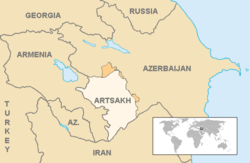Nagorno-Karabakh
Nagorno-Karabakh (Armenian: Լեռնային Ղարաբաղ; Azerbaijani: Dağlıq Qarabağ), officially the Republic of Artsakh, is a country in the Caucasus. It is internationally recognized as part of Azerbaijan, but is closely linked in every way to Armenia and accessible only through Armenia.
| WARNING: There is a very high risk of armed conflict in the Nagorno-Karabakh region and the surrounding military-occupied area in Azerbaijan. Nevertheless, the situation is relatively stable. Several ceasefire violations along the Line of Contact separating the opposing forces and elsewhere on the border took place in 2017, resulting in deaths and casualties. The UK Foreign Office advise against all travel to Nagorno-Karabakh and the military occupied area surrounding it, within 5 km of the Line of Contact, and within 5 km of the border with Armenia. | |
Government travel advisories
| |
| (Information last updated Dec 2018) |
Cities
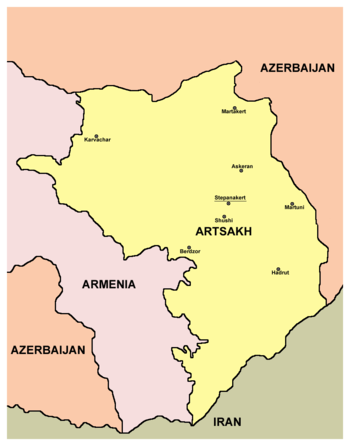
- 🌍 Stepanakert (Khankendi) — the capital is a small city and your likely base for exploring the region
- 🌍 Berdzor (Lachin) — the first town you pass through upon entering Karabakh. Shops, church and a clinic. There is also a small geological museum and art gallery worth visiting. Admission is free.
- 🌍 Hadrut — a small southern town with several nearby 13th and 14th century monasteries, and the terminus of the Janapar Trail.
- 🌍 Karvachar — administrative center of the Karvachar/Shahumyan region. Nicely sited very small town.
- 🌍 Martakert (Aghdara) — administrative center of Martakert Province with the Sarsang Reservoir
- 🌍 Martuni (Khojavend) — a small town near the small historically important Amaras Monastery
- 🌍 Shushi (Shusha) — the historic capital of Karabakh and formerly one of the cultural capitals of the Caucasus; has lots to see, although the town is largely in ruins from the war and is a shell of its former self
Other destinations
Understand
Political status
Nagorno-Karabakh has been in an indefinite state of political limbo since the 1994 ceasefire of a war in which it became independent. Under the ceasefire agreement, Azerbaijan's government has no control of the region. It remains recognized as part of Azerbaijan by all UN member states, and has been recognized only by three other self-proclaimed and unrecognized states, Transnistria, Abkhazia, and South Ossetia. Although Armenia supports Nagorno-Karabakh economically and militarily, they have not recognized the region's independence.
Background
This region has long been populated by Armenians and it has historically and culturally been part of Armenia. The Soviets, insensitive to such cultural distinctions, included it as an autonomous region of their Azerbaijan republic and so sowed the seeds of the current unrest. As Soviet dominion withered, the Armenians sought to incorporate the region into their newly independent country. This led to a war of independence, similar to those in Transnistria and in other ethnically mixed areas on the former Soviet empire's fringe.
The fighting stopped with the 1994 ceasefire and the dispute moved from the theatre of war to diplomatic circles (the OSCE Minsk Group), where the region is still squabbled over by Armenia and its Russian backers, and Azerbaijan and its Turkish allies.
Culture
During the conflict, the Azeri population fled. The region is culturally a part of Armenia. However there is a distinct border complete with immigration formalities on the road from Armenia. Investment and development in the region has invariably come from Armenians, further entrenching Armenian cultural ties.
The region is largely rural with a few small towns. Its charms lie in its historic Armenian ruins & medieval monasteries and its natural features. There's also the frisson of visiting a disputed republic (and even getting permits to visit destroyed towns near the front line).
Geography
Nagorno-Karabakh is a landlocked region in the South Caucasus, lying between Lower Karabakh and Zangezur and covering the southeastern range of the Lesser Caucasus mountains. It is mostly mountainous and forested and has an area of 8,223 km2 (3,175 mi2).
Get in
 |
Visa restrictions:
Traveling to Nagorno-Karabakh will cause problems if you have a stamped visa from Karabakh in your passport and later want to visit Azerbaijan. You can therefore decide to get your visa on a separate sheet of paper instead of as a stamp in your passport. If you have a stamp in your passport, the Azeri authorities will deny you a visa, cancel any Azeri visa you may have obtained, and ban you from their country. Upon trying to enter Azerbaijan, you will be turned away, deported, or possibly arrested.
Depending on current politics you might even have problems in Azerbaijan for having visited Armenia. Therefore, consider a trip that takes in Azerbaijan before Armenia and Nagorno-Karabakh. |
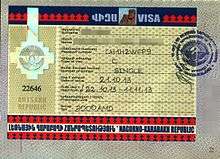
Nagorno-Karabakh can be entered only from Armenia. Doing so is considered an illegal entry into Azerbaijani territory by Azerbaijan.
Visas for Nagorno-Karabakh can be obtained (M-F 09:00 to 17:00, lunch hour from 13:00) from:
- the Permanent Mission to the Republic of Armenia, 17A Nairi Zaryan St, Yerevan, Armenia (+37410 24 97 05, nkr@arminco.com) – note, it can take up to 7 hr for the visa to be issued – or
- directly upon arrival at the Ministry of Foreign Affairs, Azatamartikneri street 28, Stepanakert (+37447 94 14 18, cons@mfa.nk.am). The latter is the easiest and unproblematic way. As of March 2015 you can just go to the Ministry of Foreign Affairs in Stepanakert – people there speak English – and within 10 minutes you will get your visa. If you arrive in Nagorno-Karabakh when the ministry is closed, you have to wait until the next working day to receive the visa and before returning into Armenia.
Tourist visas cost 3,000 dram and are usually valid for 21 days after issue. Visas with longer validity and multiple entries are also available at different but far steeper prices. An English-language version of the Foreign Office visa application is available online (in Yerevan a slightly different form is used). Visa applications in Yerevan require a 3×4 cm photograph, those in Stepanakert do not (but still accept it, of course). However, people have also received visas in Yerevan without having had photographs. Registration papers (showing the regions permitted) are issued with the visa. These papers need to be kept with you all the time and returned when leaving the region. As a tourist ask to go to all allowed areas and you will get this without any problems – it is best to mention the Janapar Trail, which crosses the whole of Nagorno-Karabakh and the most important sites, like Hadrut, Shushi, Stepanakert, Gandzasar, Dadivank and Kalbajar.
Not every local car or bus is controlled at the border. In case your bus doesn't stop at the border, don't worry and just go to Ministry of Foreign Affairs when you arrive Stepanakert.
Because the visa will not automatically be pasted into your passport, you can use it to conceal unwanted stamps. For instance, if you have visited Kosovo and now want to visit Serbia, simply cover the Kosovo stamps with the Karabakh visa, and voilà, you've never violated Serbian border integrity, and will be allowed into the country.
There are no checkpoints administrated by Armenia when entering or leaving Nagorno-Karabakh. Your original Armenian visa remains valid and is needed to continue travelling in Armenia. However, you cannot obtain a new visa when entering Armenia from Nagorno-Karabakh, so make sure your Armenian visa is valid long enough that it will not expire before you leave Armenia after re-entering the country from N-K.
By road
The main road into the region runs from Yerevan in Armenia to the region's capital Stepanakert via the Lachin Corridor, a mountain pass near the town of Lachin (Berdzor in Armenian). Another usable road crosses the Karvajar (Kelbajar) pass further north but is only open in summer.
There is at least one daily bus from Yerevan to Stepanakert, which costs 4500 dram (March 2015).
Taxi drivers in Yerevan may be willing to drive you to Stepanakert and vice versa. Expect to pay US$80–100.
The embassy in Yerevan and also tour companies there (Artsakh in Armenian) can arrange drivers to take you to Stepanakert and to show you the region's biggest attractions. This costs about US$100–150 per person.
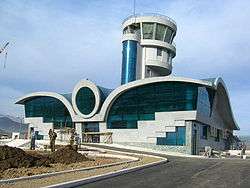
By plane
Stepanakert has the only airport in the region, and one airline, Artsakh Air. Political wrangling has prevented any planes from taking off, though. The Azeris announced to shoot down any flights that they don't control. There was some progress in 2012 towards the establishment of flights the Armenian capital, but by September 2017 there were still no flights.
Helicopter trips, however, are available.
By train
There is no working train line between Yerevan and Stepanakert.
Get around
The reconstructed Hadrut-Stepanakert-Askeran-Martakert motorway runs north-south through the region and has drastically reduced travel times to just a couple hours from just about any place in the country (excluding small villages & monasteries secluded in hilly terrain).
Stepanakert and Shushi have hotels. Shushi has a lot more specific sites of interest to see, more history, and is more interesting, while Stepanakert is right on the main highway and a lot more developed. If you're going to be heading in and out of the countryside a fair bit, you should consider that staying in Stepanakert will shave 20 minutes off of your drive in each direction.
By bus
You can reach almost every destination from the central bus station in Stepanakert. Ask there when your bus or marhsrutka starts. If you start from the central bus station your visa is controlled. From all other bus stations you can just take the bus you like without every control.
By car
If you plan to travel to Karabakh from Yerevan, there are several car rental agencies in Yerevan that provide cars which can also be driven into Nagorno-Karabakh.
If your Armenian or Russian is good, you may be able to hitch a ride for less than a taxi (although don't pay too much less, as these are certainly not affluent people), and you could very easily be invited for dinner with them (in which you should have some gift, especially wine, coffee, or chocolates, and do not offer money) as the people of Nagorno-Karabakh are doing this out of hospitality.
By taxi
Taxis are available in most cities, with a new north-south road across the Nagorno-Karabakh making for a smooth and quicker (than you'd expect) ride across the region. These cost about 120 dram/km within a town, or 150 dram/km if you take the cab out of town.
By thumb
Like the rest of Armenia, hitchhiking is extremely easy. Most cars that pass will stop, and you will be offered free food and alcohol during your ride. Wait times can be long because of the lack of traffic, but once you have gotten a ride you will likely be driven for a long distance. Hitchhiking in the north of Karabakh is more difficult because of the lack of vehicles and poor road conditions, but the friendliness of the locals will help to counteract this.
By foot
All cities are small and fairly safe, so it is best to walk around the few cities in Nagorno-Karabakh. Not only will you save a little money, but you will get a good sense of the region and its people.
Janapar Trail - One way to see much of Karabakh is simply to walk from one end to the other on the Janapar. There is a marked trail which is broken up into day hikes which extend for 2 weeks of hiking. There are side trails and alternative routes as well. Trails take you to ancient monasteries and fortresses, through forests and valleys, to hot springs and villages. Each night you can either stay with a village family or camp out.
Talk
Armenian and Russian are widely used. Karabakh Armenians speak a dialect of Eastern Armenian that differs substantially from the Armenian spoken in Yerevan - though most Karabakh Armenians can speak the Yerevan dialect if necessary, and all can understand it. Most older Karabakhtsis can speak Azeri but it is no longer used and is becoming forgotten. Relatively few locals speaks English (though those working in tourist-related areas, i.e. hotels and restaurants, often do speak a reasonable bit of English or at least can find someone around who speaks the language).
See
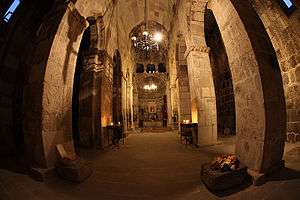
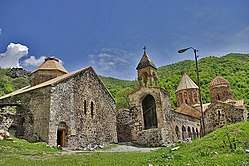
Valuable information about tourist sites is given at the website of Karabakh's travel organisation.
Tourist attractions include:
- Stepanakert, the capital city
- Shuka (Farmers market)
- Mamik and Babik (famous monument on northern outskirts)
- Shushi
- Ghazanchetsots Cathedral of the Holy Savior
- City walls
- Govharagha Mosque
- Jtrtuz overlook of Karkar Canyon
- Zontik Waterfall (1½-hour hike on Janapar Trail)
- Gandzasar monastery, main tourist attraction
- Dadivank Monastery
- Gtichavank monastery
- Amaras Monastery
- Tzitzernavank Monastery
- St. Yeghish Arakyal Monastery
- Yeritsmankants Monastery (also Yerits Mankants)
Other tourist attractions include:
- The ancient city of Tigranakert, one of four cities that were founded in the 1st century BCE in opposite corners of Armenia and named after King Tigran II the Great, ruler of the short-lived Armenian Empire. Tigranakert, which has been undegoing archaeological excavations since 2005, is located in Mardakert District.
- Askeran/Mayraberd Fortress (10th–18th centuries) served as the primary bulwark against Turko-nomadic incursions from the eastern steppe. The fort is found to the northeast of the region's capital city of Stepanakert in Askeran.
.jpg) The view from the Janapar tourist route. Section between Karintak village and the city of Shushi
The view from the Janapar tourist route. Section between Karintak village and the city of Shushi.jpg) Minarets of Ashaghi Govhar Agha Mosque in Shushi
Minarets of Ashaghi Govhar Agha Mosque in Shushi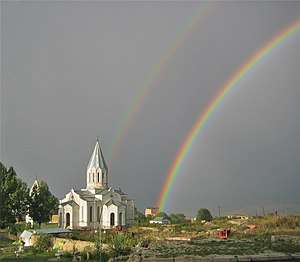 Cathedral of Shushi
Cathedral of Shushi Zontik Waterfall in Karkar Canyon
Zontik Waterfall in Karkar Canyon Gandzasar Monastery
Gandzasar Monastery 2,000 year old Skhtorashen tree
2,000 year old Skhtorashen tree Azokh Cave
Azokh Cave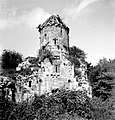 Gtichavank (old photo)
Gtichavank (old photo) Fields near Karmir Shuka
Fields near Karmir Shuka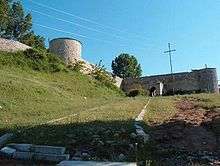 Shushi town walls
Shushi town walls.jpg) Mamik and Babik monument, the symbol of Karabakh
Mamik and Babik monument, the symbol of Karabakh
Do
The website of Karabakh's travel organisation has this website where all major events in the country is listed.
Buy
Money
|
Exchange rates for Armenian dram As of January 2019:
Exchange rates fluctuate. Current rates for these and other currencies are available from XE.com |
Nagorno-Karabakh uses the Armenian dram (֏ or AMD) for most transactions. The state bank has also issued limited amounts of another currency, Nagorno-Karabakh drams (no symbol or ISO code). The NK dram is available in 2 & 10 dram banknotes and 50 luma (0.5 dram), 1 dram, & 5 dram coins. All banknotes & coins are dated 2004. NK drams are increasingly less common, since they were printed in limited quantities, aren't worth much, and many note & coins have been taken out of the region as souvenirs or to sell to collectors. U.S. dollars & Russian rubles are accepted by some merchants, hotels and others.
The ATMs of the Karabakh's own bank named Artsakhbank do not accept Visa or Mastercards. All other banks accept them.
Shopping
There are several tourist/souvenir shops in Stepanakert. The area is known for rugs, which make good souvenirs, and it is said that many people in the region and bordering countries learned rug making from the ancient Armenians of Karabakh.
Eat
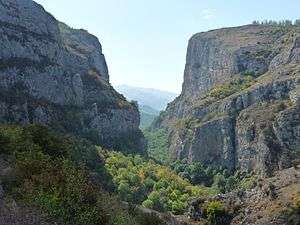
- Jingalov Hats — a bread that has greens baked into it, a local specialty.
- Tutti Chamich — mulberry raisins, available at the market (shuka)
Many Mulberry trees are to be found, but make sure to eat only ripe fruit - a dark black/red or a pure white. They should not have any green, and should be plump and sweet.
Drink
Tutti Oghi — Mulberry Vodka, which Karabakh is famous for, often reaching 80% alcohol, and with a distinct taste.
Sleep
See Stepanakert.
- Hotel Eclectic — a crazy hotel in the small village of Vank, about 40 km north of Stepankert. The hotel is meant to resemble the Titanic and was built by a Russian-based Armenian businessman who was born in Vank. Nice rooms from 8,000 dram. There is a swimming pool at one of the hotel "decks".
Work
Limitless volunteer work for the willing. Incredibly low cost of living. The government will gladly give most people land as long as they are willing to farm and tend to it.
Stay safe
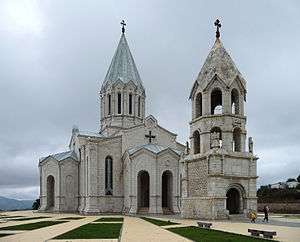
Western governments advise their citizens to avoid the region but in spite of that, hundreds of westerners visit Nagorno-Karabakh every year.
Don't venture east of the Mardakert-Martuni highway, where the ceasefire line is located. Otherwise, it is very safe to travel around and interact with people. When you first arrive in Karabakh, you must go to what is called the "MIT", the Stepanakert foreign affairs office, to get your travel papers. This will prevent any confusion if one gets pulled over or stopped by local authorities.
If you are planning to hike, be in rural areas, or stay on the outskirts of cities note that the area is inhabited by bears and wolves. While they will not attack if unprovoked, practice bear safety and walk away slowly if unexpectedly approached. If you are planning to hike, the Janapar Trail has been broken into day-long hikes and it is best to take advantage of the homestays offered rather than to camp alongside the trails. If you do camp, make sure to keep your food high in a tree and a few dozen meters (a hundred feet or so) from your tent and do not simply sleep on the ground or in a sleeping bag. Sleep inside a tent.
While the region is fairly safe in terms of crime, you must not lose your passport. There are no foreign embassies in the Nagorno-Karabakh, and you may have a hard time leaving Nagorno-Karabakh without a passport or visa. The US embassy in Baku says that "because of the existing state of hostilities, consular services are not available to Americans in Nagorno-Karabakh." It would be safe to assume that this applies to all other nationalities and their embassies in Baku.
Stay healthy
Drink bottled water if you are not accustomed to the local water. However if you are hiking, drinking water in mountain streams and ponds in reasonably safe, as long as you are sure it is not downstream from a large town (in which case it is likely contaminated with chemicals, street runoff, and/or waste.
This is a rural region: in the event of a medical emergency the hospitals in Nagorno-Karabakh are no more than a modest clinic. The nearest major hospital is in Yerevan, a long distance in the event of a heart attack or complications with any medical problems you may have. It is best to have with you a small first aid kit with bandaids, bandages, anti-biotic cream, ibuprofen, and any other medicine you may need.
Respect
The people of Nagorno-Karabakh are very friendly and inviting, and if your Armenian or Russian is good enough, you will easily meet people who will invite you to their house for dinner (and some will even harass you until you accept). Unlike many parts of the world, you should not worry about your safety, no matter how much they harass you, and accept their invitation. Even though these people do not have much and, like many persons in developing countries, view westerners as rich, they will vehemently refuse any type of money given to them (although you may find luck saying it is "for the children"). However, do not show up empty-handed! You will be expected to bring some sort of gift, with food (wine, chocolates, coffee, etc.) being best. You should also bring something to show/give them from your home country (postcard, book, photos, etc.) to have a conversation or at least get their interest. You never know, they may likely have family in another place and what you thought was just dinner could turn into inviting you to other family's businesses (discounts), homes (to stay the night), or another meal.
The wiki on the Janapar trail recommends no trace camping and if you bathe, make sure no locals are around (it may be offensive). Just as stated above, you will receive offers of food and rest. Have gifts for such people, but do not offer money.
Connect
It is recommended to have a SIM card of the company Vivacell. All other phone operators that are active in this region refuse for political reasons roaming inside Karabakh.
Alternatively get a SIM card from Karabakh's own phone company Karabakh Telecom when you are in Stepanakert. All you need is your passport and 1200 dram. This includes the cost for the SIM card and 600 dram as initial money in your account. Using mobile Internet is also possible. The Karabakh Telecom's main office in the Vardan Mamikonyan Str. 23 in Stepanakert has personnel speaking English. They can also help you if you have technical problems with your phone.
